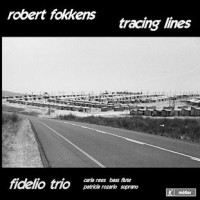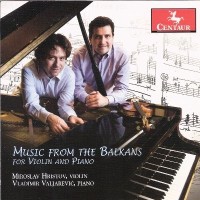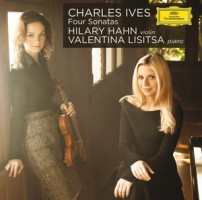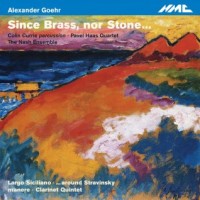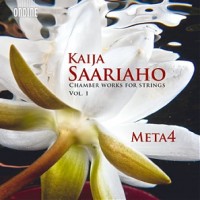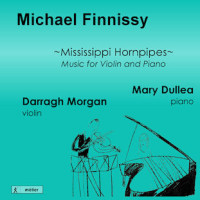String Theory 12: Violin (with Piano, Mostly)
|
Grant Chu Covell [September 2015.]
Robert FOKKENS: Tracing Lines (2007)1; Inyoka Etshanini (2007)2; Mammals of Southern Africa (2011)3; Nine Solitudes (2006)4; On Disruption and Displacement (2004)5; Irreconcilable Truths (2002)6; Africa (2007)7. Patricia Rozario7 (sop), Carla Rees2 (b-fl), The Fidelio Trio: Darragh Morgan1,2,3,6 (vln), Robin Michael1,2,3,5 (vlc), Mary Dullea3,4,5,6,7 (pno). Metier MSV 28535 (1 CD) (http://www.divine-art.co.uk/). Looking back across the past few months, this disc was spun many more times than most. I have returned to this release to restore my faith in new music of this century on more than one occasion. It’s also excellently played and recorded, as we should expect from Metier. Fokkens declares a natural and mature style through efficient notes and rhythm. Quartertones abound as subtle inflections within invented tunes, not as avant-garde effects. An aspect of Fokkens’ work concerns identity: He is a white South African working with European contemporary music and forms and incorporating African sensibilities and influences: “At the core of these pieces are techniques learned from traditional Xhosa bow music.” The results are direct and non-flamboyant. Spare without being simple, complex through precise placement of unexpected accents, note lengthening and mood changes. The first movement of a three-part duo for violin and cello, Tracing Lines, balances gentle irregular violin rocking against a climbing cello line in the Lydian mode. The magic is that the parts appear momentarily to switch, except that the work takes a different path and then abruptly ends. Mammals of South Africa for piano trio (“Ingwe (Leopard),” “Southern Right,” “Mob of Meerkats,” “Lioness with cub,” “ImVubu (Hippopotamus)”) parades with a lithe economy. Another trio adds bass flute to the more common pair of violin and cello: Inyoka Etshanini is Zulu for “snake in the grass.” As seems typical to Fokkens’ music, massed forces are rarely used and so players may literally slither through one another. Nine Solitudes are etudes, compact explorations of tiny gestures. Some of the etudes are variations on material introduced at the outset. Ligeti comes to mind, but these are more humane. In On Disruption and Displacement cello and piano elbow each other with contradictory materials: abrupt chords, ornamented soliloquies. The violin and piano Irreconcilable Truths also explores conflict. These two duos are the earliest pieces here and are perhaps more traditionally contemporary and academic. The final item, Africa, a sober song for soprano and piano (text by French Senegalese / Cameroonian David Diop), returns to some of Fokkens’ more current interests: rocking material, melodies with raised fourths.
“Music from the Balkans for Violin and Piano.” George ENESCU: Sonata for Violin and Piano No. 3, Op. 25 (1926). Çesk ZADEJA: Sonata for Violin and Piano (1972-74). Aleksandra VREBALOV: Eastern Chapel Mediations (2010). Nikos SKALKOTTAS: Petite Suite No. 2 (1946). Pantcho VLADIGEROV: Song from Bulgarian Suite, Op. 26 (1926, arr. 1951). Miroslav Hristov (vln), Vladimir Valjarević (pno). Centaur CRC 3208 (1 CD) (http://www.centaurrecords.com/). Hristov and Valjarević offer passion and clarity in a well-designed recital. The Enescu may be the most familiar, but the duo adds improvisational flair as well as expressive intonation. The instigator of Albanian classical music, Zadeja develops folk tunes in his two-movement Sonata which stand up well against Enescu’s. Vrebalov adds tape to interior piano sounds and long cantilena violin lines. The depiction is of Manhattan’s Upper West Side centering upon the St. Savior Chapel in St. John’s Cathedral. A onetime Schoenberg student, Skalkottas’ Petite Suite is but three energetic movements, folk-inspired but angular and quasi-atonal. No Balkan program is complete without Vladigerov, Bulgaria’s preeminent voice, and the familiar Song makes an effective conclusion.
Charles IVES: Sonata for Violin and Piano, No. 1 (1901-17); Sonata for Violin and Piano, No. 2 (1901-17); Sonata for Violin and Piano, No. 3 (1901-14); Sonata for Violin and Piano, No. 4, “Children’s Day at the Camp Meeting” (1900-16). Hilary Hahn (vln), Valentina Lisitsa (pno). Deutsche Grammophon DG 0289 477 9435 6 (1 CD) (http://www.deutschegrammophon.com/). Hahn is an unexpected Ives champion. However her faultless playing inclines Ives towards uncharacteristic dreariness. All the notes may be in the right place but there is almost no iconoclastic swagger in her consistent tone. These are not easy pieces, and on the surface Hahn and Lisitsa are superb. However, tricky moments, such as in the abruptly concluding No. 4 where triplets pass across square textures, are here delivered with such exactitude when most likely Ives meant the duo to pretend to falter.
“Since Brass, nor Stone…” Alexander GOEHR: Since Brass, nor Stone…, Op. 80 (2008)1; …around Stravinsky, Op. 72 (2002)2; Clarinet Quintet, Op. 79 (2007)3; manere, Op. 81 (2008)4; Largo Siciliano, Op. 91 (2012)5. Colin Currie1 (perc), Pavel Haas Quartet1: Veronika Jarůšková, Marek Zwiebel (vln), Pavel Nikl (vla), Peter Jarůšek (vlc). The Nash Ensemble: David Alberman2,3,4, Laura Samuel3, Marianne Thorsen5 (vln), Lawrence Power3 (vla), Paul Watkins3 (vlc), Richard Watkins2,5 (hn), Richard Hosford2,4 (clar), Gareth Hulse2 (ob), Ursula Leveaux2 (bsn), Ian Brown5 (pno). NMC D187 (1 CD) (http://www.nmcrec.co.uk/). This program proposes that Goehr has achieved a welcome degree of mellowness, and perhaps Stravinsky is a key to this late music. Indeed …around Stravinsky wraps a solo violin prelude, “Dushkin,” and an Introduzione and Rondo around Stravinsky’s own Pastorale for violin and wind quartet. On this program, the subsequent Clarinet Quintet with ten movements, a concertante for the lone wind player, flows absentmindedly. Manere revisits the Stravinskian fragments from earlier in the program in a well-matched multi-movement duet for clarinet and violin. The horn trio, Largo Siciliano, is bluntly Romantic, requiring and receiving blatant lyric playing. The horn’s soft gestopft suggest a fourth instrument. Like the Quintet, it too meanders as it fills out 20 minutes. The title piece for percussion and string quartet may be the oddity, as the unpitched timbres and harsh string writing display assertiveness absent from the Nash Ensemble’s liquid delivery of the other pieces.
“Chamber works for strings, Vol. 1.” Kaija SAARIAHO: Tocar (2010)1; Vent nocturne (2006)2; Calices (2009)3; Spins and Spells (1997)4; Nocturne (1994)5; Nymphéa (1987)6. Meta4: Antti Tikkanen3,6, Minna Pensola1,5,6 (vln), Atte Kilpeläinen2,6 (vla), Tomas Djupsjöbacka4,6 (vlc), Anna Laakso1,3 (pno), Marko Myöhänen2,6 (electronics). Ondine ODE 1222-2 (1 CD) (http://www.ondine.net). I’ve run hot and cold over Saariaho across the years. With this disc, I realize I prefer her earlier, generally uglier and noisier textures which may include electronics. There are recent works that sound too much like Debussy and I don’t understand the apparent regression. This collection’s largest item, the 21:35 Nymphéa, for string quartet and live electronics, fits the bill with enveloping waves of grainy processed quartet and coarse string machinations. Perhaps Meta4 intends to make this music as rough and aloof as possible. Indeed the solo pieces, Spins and Spells for cello, and Nocturne for violin, command attention because of their indifference and unpredictability. Two works pair violin and piano, Tocar and Calices, which both avoid conventional maneuvers. Vent nocturne is two movements for viola and electronics.
Michael FINNISSY: Mississippi Hornpipes (1982); Seterjentends Fridag (2003); Amphithéâtre des Science Mortes (2001-02); Jive (2006); Molly House (2003-04); Violin Sonata (2007). Darragh Morgan (vln), Mary Dullea (pno), Michael Finnissy (second keyboard). Metier MSV 28545 (1 CD) (http://www.divine-art.co.uk/). Here’s a fine collection offering sightlines into Finnissy’s raucous density. The composer often favors a technique of assembling new structures from history’s shards and not caring a whit whether the breaks and seams show. Here Morgan and Dullea explore American fiddle tunes (Mississippi Hornpipes), Norwegian Hardanger-fiddle tunes (Seterjentends Fridag) and willfully mis-notated Handel arias (Molly House). This could be incomprehensible and pretentious, but Morgan and Dullea find the life and soul throughout. Vacuum and hair dryer add comic touches to Molly House. Jive is a mere 31 seconds. I’m reminded of the chaos readily overheard in music conservatories where multiple practicing instrumentalists can be heard simultaneously, repeatedly laboring over phrases or fumbling through something familiar. Several of these pieces are in fact “kits” whose parts are assembled by the players: Amphithéâtre des Science Mortes and Molly House. Finnissy joins in here and there in these exemplary performances.
[More Grant Chu Covell, String Theory]
[Previous Article:
Eight Beacons]
[Next Article:
EA Bucket 22: Including Solo Instruments]
|
